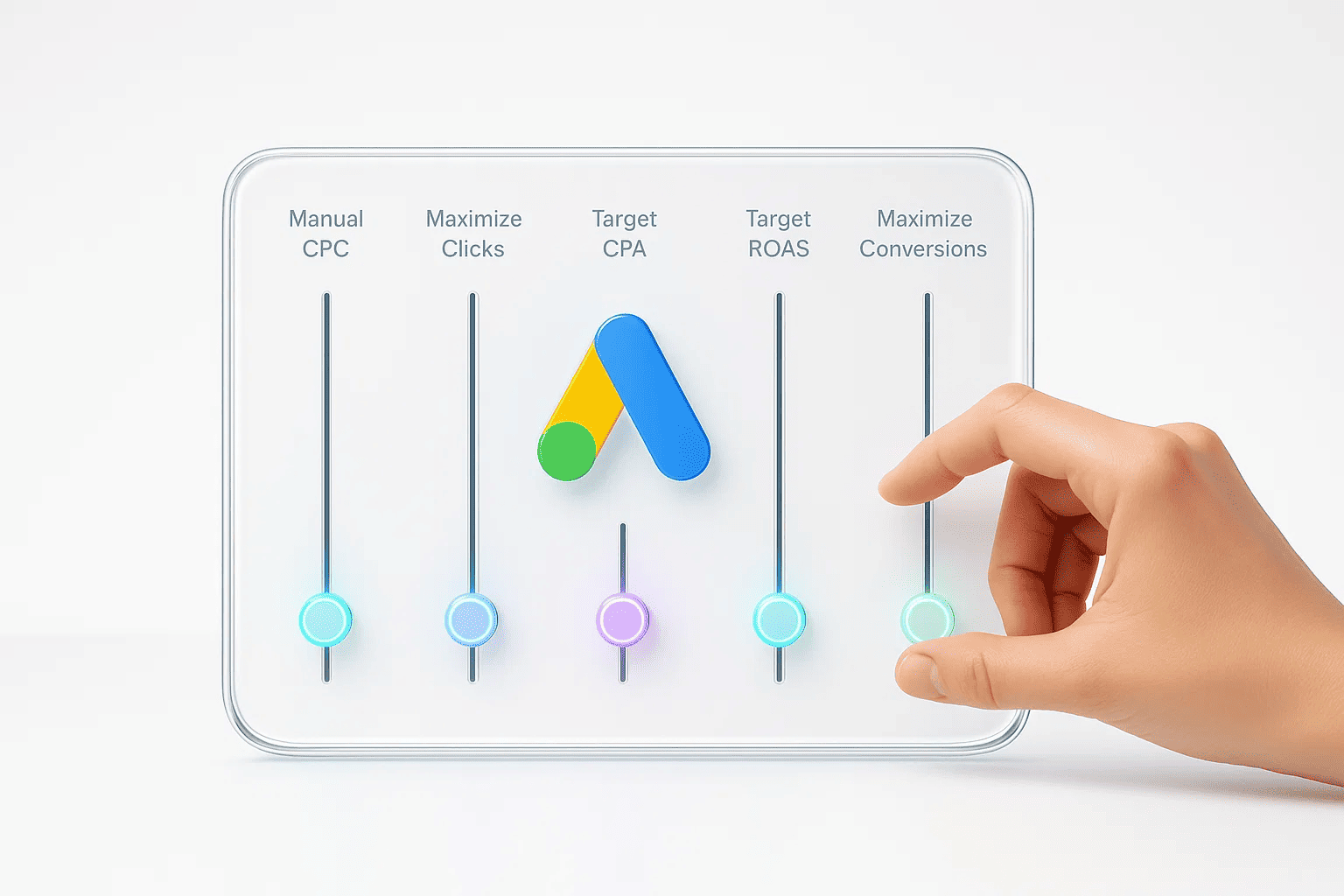
BIDDING STRATEGIES IN GOOGLE ADS: HOW TO CHOOSE THE RIGHT ONE
The right choice of a bidding strategy is one of the key factors for success in contextual advertising. That’s why doing everything randomly or leaving it by default, as Google recommends, is not the best strategy. Which one is better — we will figure out right now, and not just figure it out, but give 13 practical tips, tested and earned through blood, sweat, and constant practice since 2016.
What will be covered
- What is a bidding strategy?
- Manual strategies
- Automated strategies
- Practical tips for setting bidding strategies
- Conclusions
What is a bidding strategy in Google Ads?
A bidding strategy in Google Ads is an approach by which the system determines bids to achieve specific campaign goals, which may include: clicks, conversions, conversion cost, conversion value, profitability, impressions, or views.
The choice of strategy is influenced by factors such as:
- the ability to set up accurate conversion tracking;
- business goals and KPIs;
- advertising budget size;
- industry and business specifics;
- level of market competition;
- readiness to spend time on optimization and campaign management;
- length of the customer decision-making cycle;
- other specific business factors.
Next, we will look at the most popular strategies for lead-gen and e-commerce businesses. For brand awareness and audience reach goals, there are additional strategies such as Target CPV (Cost Per View), Target CPM (Cost Per Mille), etc., which are not covered in this article.
In general, all bidding strategies in Google Ads can be divided into two fundamental types: manual and automated, which in turn are divided into smart and non-smart.
Manual strategies in Google Ads
Among manual strategies, only the classic manual bidding strategy remains. Previously, there was an extended manual strategy with automation elements (Conversion Optimizer, Enhanced CPC), but Google has completely abandoned it.
Manual strategy is appropriate when maximum precise control over bids is required.
Examples of situations when it is worth using:
- when you want to fine-tune the work of the campaign and each ad group or keyword;
- when the budget is very limited and it is impossible to ensure 15+ conversions per month for training smart algorithms;
- when you manage advertising yourself, or the contractor has enough time and resources for constant manual control;
- when you are ready to set bids for each keyword separately, considering its performance, importance for the business, and stage of the sales funnel. For example, you can set low bids for broad informational keywords and high bids for the most targeted and “hot” ones.
A real-life example: a client in the online education niche had campaigns that started generating spam traffic, which caused smart algorithms to train on false data and, as a result, work inadequately and significantly inflate the cost per click, which did not justify itself and did not bring leads. The solution was temporary — until we implemented an anti-spam solution, we applied manual bidding strategies in search campaigns with cost-per-click limits.
As a result, the cost per click decreased, and campaigns began to receive more traffic with the same overall spend.

📌 Read the article: What is CPL (Cost Per Lead) and how to calculate it
Automated strategies in Google Ads
In Google Ads, all automated bidding strategies are divided into smart and non-smart.
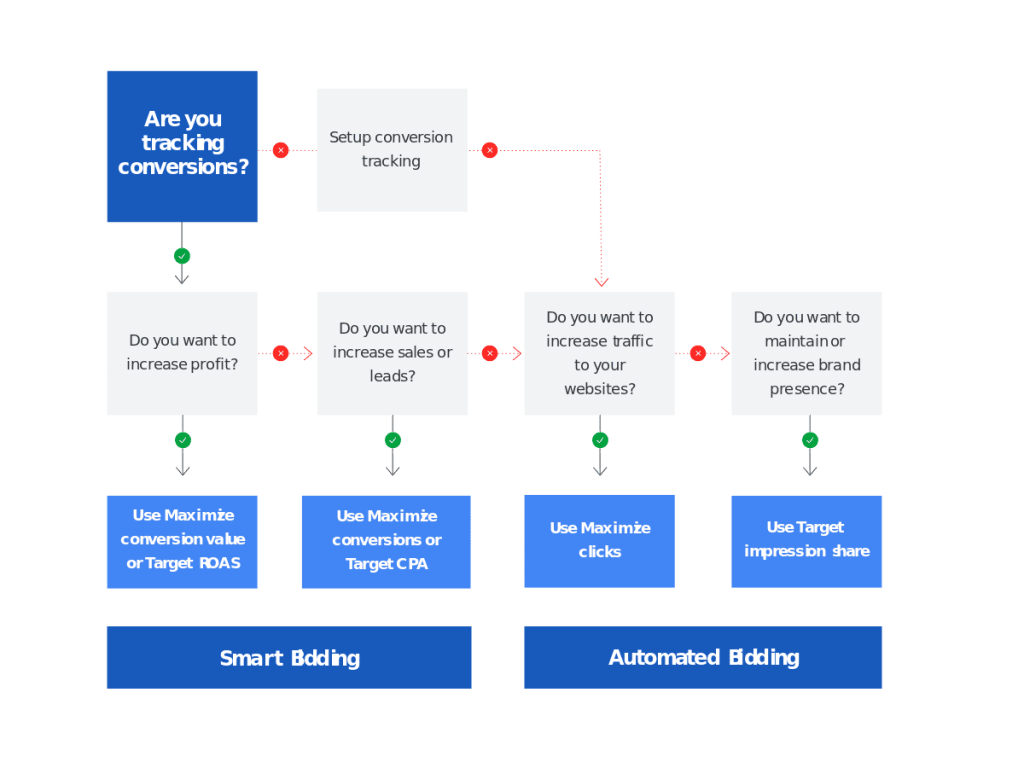
Non-smart
Non-smart automated strategies that do not require conversion tracking or do not use it for bid optimization include:
- Maximize Clicks
- Target Impression Share
Maximize Clicks
Used when:
- the main goal is to increase website traffic;
- conversions are not a priority.
In this case, Google tries to generate the maximum number of clicks within the set budget.
Situations when the strategy is appropriate:
- at the start of an advertising campaign for a “boost”;
- if it is important just to attract visitors to the site, regardless of their further actions;
- when conversion tracking does not work or cannot be set up.
Target Impression Share
Google automatically sets bids to achieve the specified impression share: at the top of the page, in the first position, or overall in search results.
This strategy, like Maximize Clicks, does not focus on conversions but can be effective:
- in highly competitive niches with a very short decision-making cycle, when a user needs to quickly satisfy an urgent need (emergency locksmith services, urgent medical help, taxi, legal assistance after an accident);
- for branded search campaigns, to get the maximum number of ad impressions and outrun competitors who advertise on your branded keywords.
Example of using a non-smart automated strategy: in a branded campaign for a client in the bicycle sales niche, we applied the “Target Impression Share” strategy.
The client’s store name matches a competitor’s name (only the domain zones differ), and there are also other competitors who use our branded keywords.
We applied the “Target Impression Share” bidding strategy at the 100% level for the highest position, additionally setting a $1–10 CPC limit as an extra safeguard against overspending.
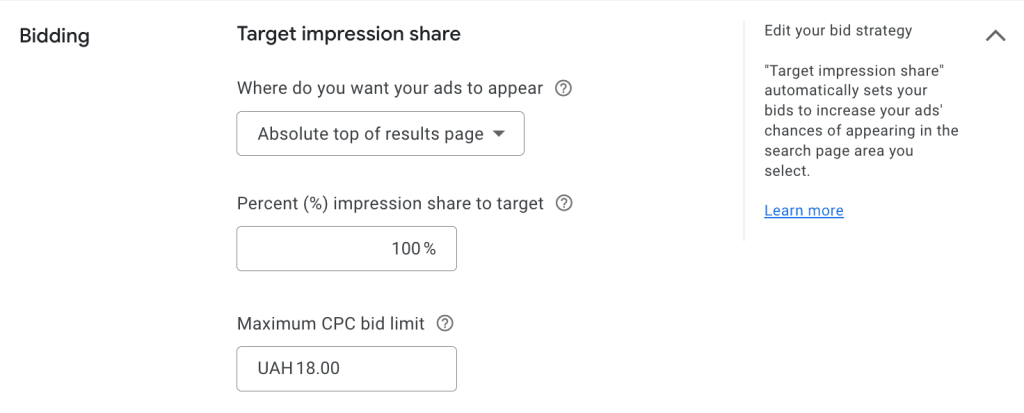
This helps us get the maximum impression share among competitors, always appear in the highest search position, and squeeze the most out of the hottest and most loyal traffic.
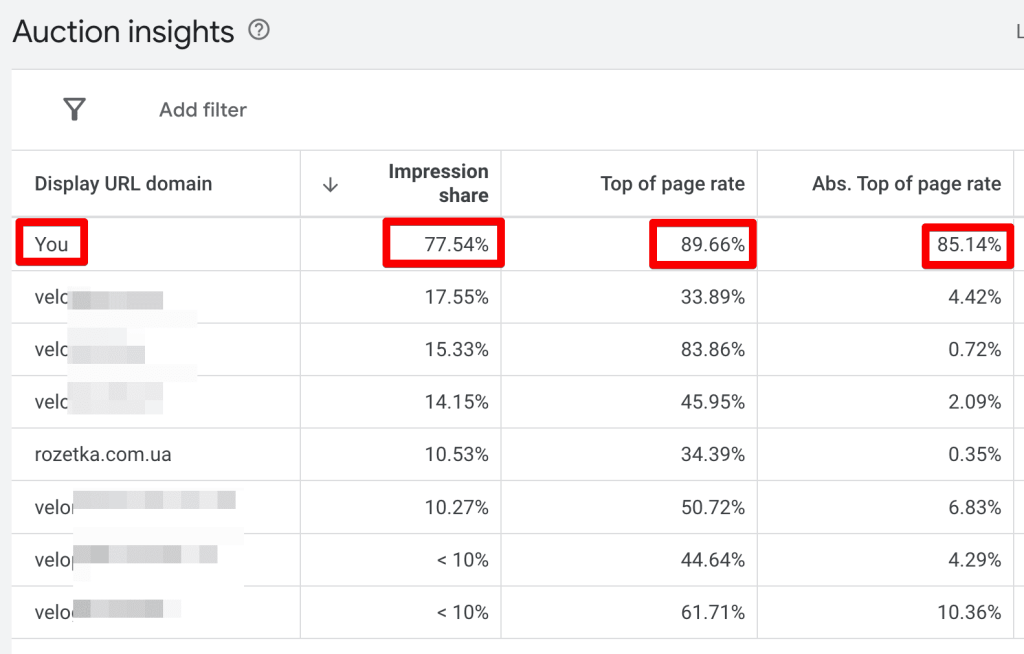
Smart bidding strategies in Google Ads
Smart Bidding strategies use machine learning (AI), conversion or conversion value data, as well as hundreds of additional signals (for example, user device, geographic location, time of day, demographic characteristics, browser type, website behavior, etc.) to automatically determine bids depending on the set goal.
For Smart Bidding to work effectively, you need at least 15–20 real, targeted, correctly tracked conversions per month. The more data, the more accurately the algorithms determine the target audience profile and adjust bids depending on the likelihood of conversion and the stage of the funnel where the user is.
There are the following types of smart strategies:
- Maximize Conversions
- Target CPA (Cost Per Action)
- Maximize Conversion Value
- Target ROAS (Return on Ad Spend)
Maximize Conversions
This strategy is suitable if the goal is to get as many conversions as possible within the set budget.
Target CPA
Google will set bids to get not just as many conversions as possible but at the specified target cost per conversion.
Maximize Conversion Value
This strategy automatically optimizes and sets bids to get the highest total conversion value within the set budget.
This strategy, like Target ROAS, is usually used in e-commerce projects where the value is the product price. In this case, the algorithms focus on sales revenue rather than quantity.
Maximize Conversion Value also works well in lead-gen businesses. But assign conditional value to different conversions depending on their importance to the business.
📌 Read the article: What is CTR and what formula is used to calculate it
Example:
- a lead through an extended form with many required fields, signaling that the user is clearly interested in the offer — 1000 units;
- a lead through a simple form with name and phone number — 500 units;
- a call to the manager — 500 units;
- a click on the email — 200 units;
- downloading a price list — 100 units.
The system will optimize bids to get conversions with higher commercial value, but at the same time will not ignore less significant conversions.
Target ROAS (Return on Ad Spend)
The system will set bids not only to get the highest conversion value but also within the specified profitability level.
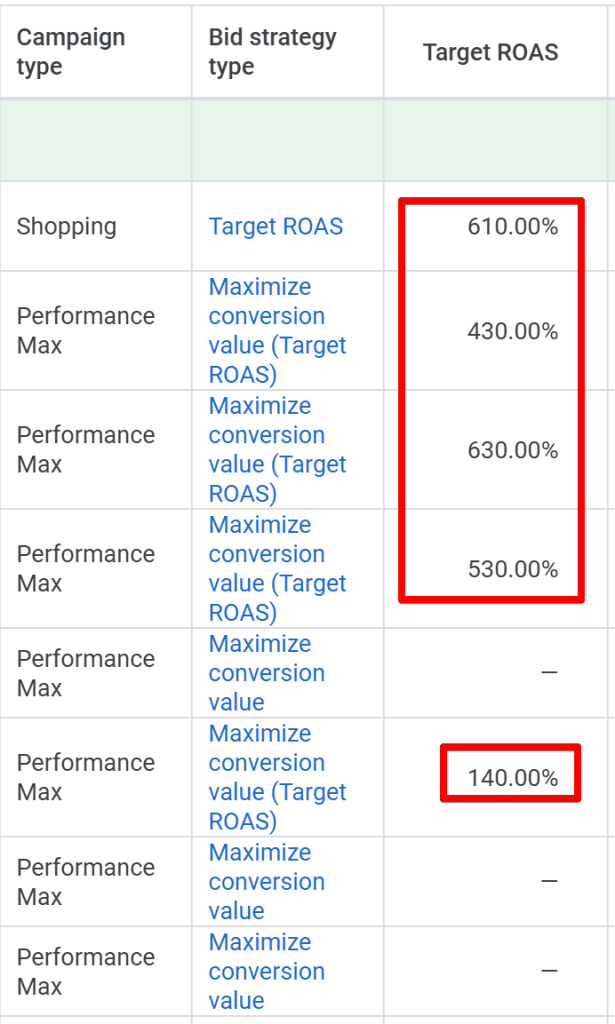
Example of using Smart Bidding: for a client in the power tools sales niche in the U.S., we applied the “Target ROAS” 500% strategy in a Standard Shopping campaign, replacing manual bidding.
As a result, sales grew rapidly, the actual ROAS even exceeded the target value and reached 1065%, and the campaign became the client’s main source of sales and revenue.
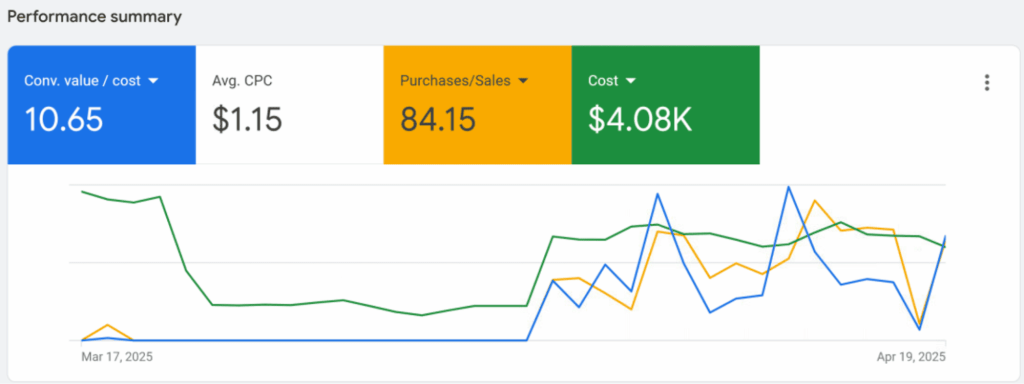
Practical tips for setting bidding strategies
- Check that all conversions in Google Analytics 4 and Google Ads are tracked correctly and accurately. Without this, no automated strategy will work effectively.
- Make sure that only those conversions that are truly valuable for the business and directly related to potential revenue are set as primary.
- Set Maximize Conversions or Maximize Conversion Value if you are working with small budgets in highly competitive niches with high CPC and you only get 1–2 clicks per day.
- Set Maximize Clicks (if there is no conversion history) or Maximize Conversions (if the account already has at least 15 conversions per month) for a quick launch of new campaigns, testing a niche, collecting initial statistics, and understanding the competitive environment.
- Launch new campaigns on Target CPA or Target ROAS in accounts with a sufficient volume of conversions, gradually adjusting the target values depending on the actual CPA/ROAS indicators of the campaign and the amount of traffic.
Remember: the actual CPA/ROAS almost always differs from the target values. Target indicators are more of a traffic volume management tool:
Lower target CPA / higher target ROAS → ads show less often, reach decreases.
Higher target CPA / lower target ROAS → the algorithm works more freely, attracts a wider audience, and participates in more auctions.
If, for example, in the business consulting niche you set a target CPA of $0.5 — there will be almost no impressions. Therefore, always focus on the real market situation, competitors, and the average conversion cost in your niche.
Test different values until you get close to the golden mean in terms of traffic volume and desired actual CPA/ROAS indicators. - If you use smart bidding strategies, make any major changes in campaigns (budget, GEO, massive keyword changes) carefully and gradually — otherwise, the campaign will switch to relearning mode.
- Get at least 15 primary conversions per month in the account (better 30+, ideally hundreds) for stable and effective performance of smart strategies.
- If you cannot reach at least 15 primary conversions per month (due to low budgets, a difficult niche, a long decision-making cycle, or inability to properly set up conversion tracking), then:
- use manual or non-smart automated strategies;
- temporarily set and mark micro-conversions as primary as well (click on phone, start filling out a form, go to the contacts page, view more than 5 pages, etc.)
- Even if the account has no conversions and overall results are weak, still test smart bidding strategies. Although optimization formally relies on data from a specific campaign, the algorithms also use information from the entire account and apply global Google models and behavioral signals trained on data from accounts in the same or similar business niches. Because of this, such strategies often show better results than manual or simple automated bidding, even with a lack of conversions.
- Do not immediately turn off a campaign if it shows weak results on the current smart strategy, for example, “Maximize Conversions.” Try restarting a copy of the campaign on the same strategy for algorithm relearning or change the strategy, for example, to “Maximize Conversion Value,” so the algorithms optimize for conversions with higher commercial value and adapt to a potentially more effective audience.
- If technically possible — set up import from CRM into the ad account of only those conversions that turned into real sales or closed deals. After this, Google will start “learning” from users who actually buy, not just submit leads, which improves optimization accuracy and bidding efficiency.
- If you use “maximize” strategies (“Maximize Conversions” or “Maximize Conversion Value”) you can indirectly influence efficiency by adjusting the daily budget:
- Increasing the budget may decrease actual ROAS and increase CPA.
- Decreasing the budget may increase actual ROAS and lower CPA.
- Test portfolio bidding strategies for multiple campaigns, especially if they target a similar audience. This allows algorithms to use shared conversion data from several campaigns, accelerates learning, and increases optimization efficiency. In addition, for some portfolio strategies, you can set minimum and maximum CPC — a feature not available in standard strategies.
Conclusion
In Google Ads, the bidding strategy decides more than it seems. Sometimes just changing it is enough — and the campaign comes to life, even without rewriting ads, selecting new keywords, or making other adjustments.
The main thing is to give the algorithms the right “food”: high-quality and accurate conversions. Without this, no strategy will perform at its maximum.
Therefore, test, try different options, and see what really works for you. In Google Ads, there is no magic button, but there are tools that, in the right hands, deliver very tangible results.
FAQ
It is an approach by which the system determines bids to achieve specific campaign goals, which may include: clicks, conversions, conversion cost, conversion value, profitability, impressions, or views.
The best results come from smart automated bidding strategies (Smart Bidding), but for them to work effectively, the account must accumulate a sufficient volume of high-quality and valuable business conversions.
